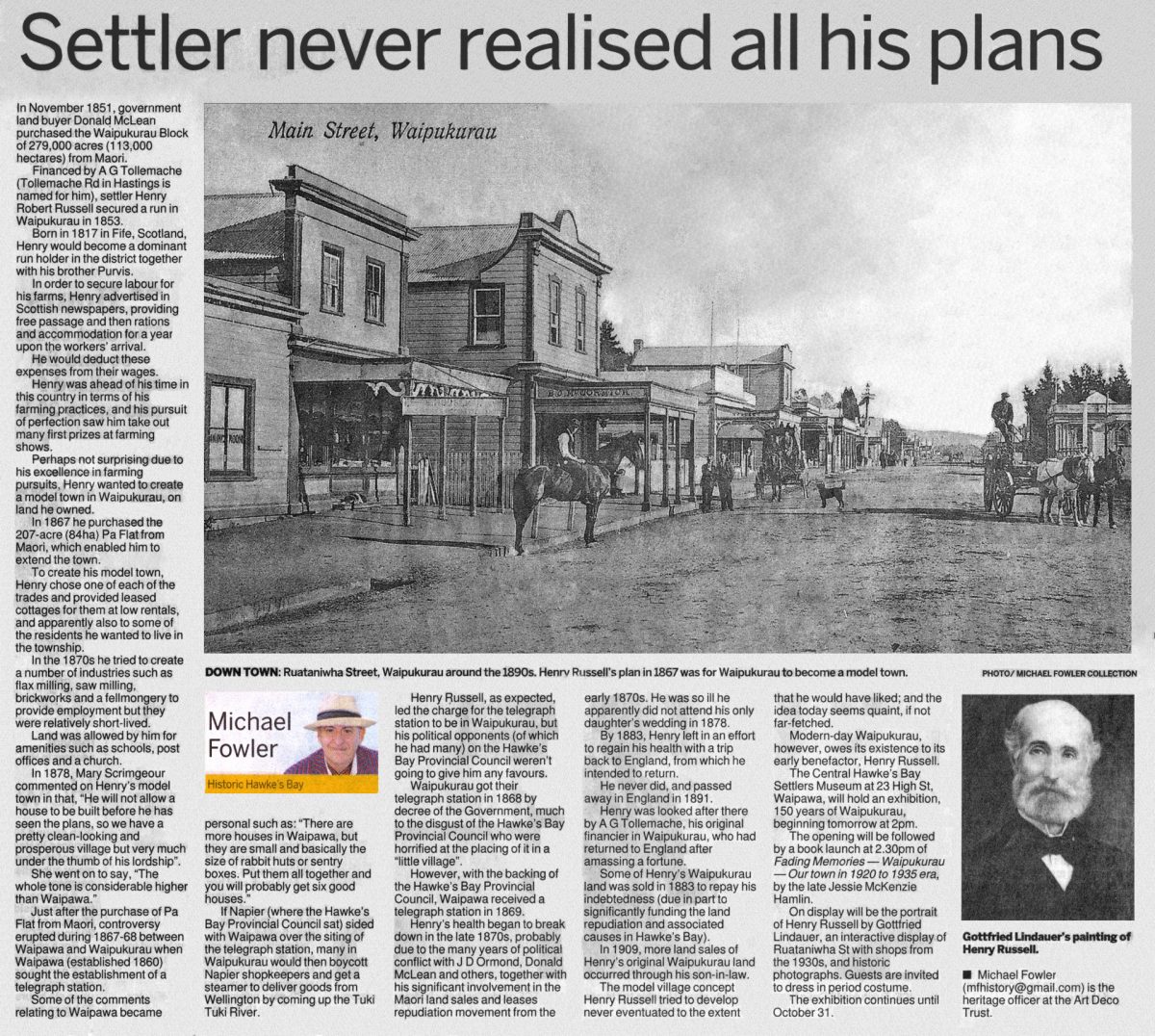Settler never realised all his plans
In November 1851, government land buyer Donald McLean purchased the Waipukurau Block of 279,000 acres (113,000 hectares) from Maori
Financed by A G Tollemache (Tollemache Rd in Hastings is named for him), settler Henry Robert Russell secured a run in Waipukurau in 1853.
Born in 1817 in Fife, Scotland, Henry would become a dominant run holder in the district together with his brother Purvis.
In order to secure labour for his farms, Henry advertised in Scottish newspapers, providing free passage and then rations and accommodation for a year upon the workers’ arrival.
He would deduct these expenses from their wages.
Henry was ahead of his time in this country in terms of his farming practices, and his pursuit of perfection saw him take out many first prizes at farming shows.
Perhaps not surprising due to his excellence in farming pursuits, Henry wanted to create a model town in Waipukurau, on land he owned.
In 1867 he purchased the 207-acre (84ha) Pa Flat from Maori, which enabled him to extend the town.
To create his model town, Henry chose one of each of the trades and provided leased cottages for them at low rentals, and apparently also to some of the residents he wanted to live in the township.
In the 1870s he tried to create a number of industries such as flax milling, saw milling, brickworks and a fellmongery to provide employment but they were relatively short-lived.
Land was allowed by him for amenities such as schools, post offices and a church.
In 1878, Mary Scrimgeour commented on Henry’s model town in that, “He will not allow a house to be built before he has seen the plans, so we have a pretty clean-looking and prosperous village but very much under the thumb of his lordship”.
She went on to say, “The whole tone is considerable higher than Waipawa.”
Just after the purchase of Pa Flat from Maori, controversy erupted during 1867-68 between Waipawa and Waipukurau when Waipawa (established 1860) sought the establishment of a telegraph station.
Some of the comments relating to Waipawa became personal such as: “There are more houses in Waipawa, but they are small and basically the size of rabbit huts or sentry boxes. Put them all together and you will probably get six good houses.”
If Napier (where the Hawke’s Bay Provincial Council sat) sided with Waipawa over the siting of the telegraph station, many in Waipukurau would then boycott Napier shopkeepers and get a steamer to deliver goods from Wellington by coming up the Tuki Tuki River.
Henry Russell, as expected, led the charge for the telegraph station to be in Waipukurau, but his political opponents (of which he had many) on the Hawke’s Bay Provincial Council weren’t going to give him any favours.
Waipukurau got their telegraph station in 1868 by decree of the Government, much to the disgust of the Hawke’s Bay Provincial Council who were horrified at the placing of it in a “little village”.
However, with the backing of the Hawke’s Bay Provincial Council, Waipawa received a telegraph station in 1869.
Henry’s health began to break down in the late 1870s probably due to the many years of political conflict with J D Ormond, Donald McLean and others, together with his significant involvement in the Maori land sales and leases repudiation movement from the early 1870s. He was so ill he apparently did not attend his only daughter’s wedding in 1878.
By 1883, Henry left in an effort to regain his health with a trip back to England, from which he intended to return.
He never did, and passed away in England in 1891.
Henry was looked after there by A G Tollemache, his original financier in Waipukurau, who had returned to England after amassing a fortune.
Some of Henry’s Waipukurau land was sold in 1883 to repay his indebtedness (due in part to significantly funding the land repudiation and associated causes in Hawke’s Bay).
In 1909, more land sales of Henry’s original Waipukurau land occurred through his son-in-law.
The model village concept Henry Russell tried to develop never eventuated to the extent that he would have liked; and the idea today seems quaint, if not far-fetched.
Modern-day Waipukurau, however, owes its existence to its early benefactor, Henry Russell.
The Central Hawke’s Bay Settlers Museum at 23 High St, Waipawa, will hold an exhibition, 150 years of Waipukurau, beginning tomorrow at 2pm.
The opening will be followed by a book launch at 2.30pm of Fading Memories – Waipukurau – Our town in 1920 to 1935 era, by the late Jessie McKenzie Hamlin.
On display will be the portrait of Henry Russell by Gottfried Lindauer, an interactive display of Ruataniwha St with shops from the 1930s, and historic photographs. Guests are invited to dress in period costume.
The exhibition continues until October 31.
Michael Fowler ([email protected]) is the heritage officer at the Art Deco Trust.
Photo captions –
Main Street, Waipukurau
DOWN TOWN: Ruataniwha Street, Waipukurau around the 1890s. Henry Russell’s plan in 1867 was for Waipukurau to become a model town. PHOTO/MICHAEL FOWLER COLLECTION
Gottfried Lindauer’s painting of Henry Russell.












Do you know something about this record?
Please note we cannot verify the accuracy of any information posted by the community.